#peppered moth
Text
Moth of the Week
Peppered Moth
Biston betularia

The peppered moth is a part of the family geometridae. It was first described in 1758 by Charles Linnaeus. This moth gains its name from its speckled coloration, which has been studied as an example of natural selection and population evolution.
Description This species has a short body with narrow forewings. The body and wings are the same white base peppered with black dots and irregular black lines. This speckled pattern may vary with some moths having very few spots and others having so many that they look as if they are black with white spots as opposed to white with black. In rare cases, the black on the wings and body is replaced with gray or brown and in even rarer cases the spots are a combination of brown and black/gray. These spots help the moth camouflage against lichen on trees.
The evolution of this moth had been studied extensively during the last two hundred years, which created the term “industrial melanism.” During the Industrial Revolution, air pollution killed off lichen and covered trees in soot. This caused moths with a black spots on white base (typica) coloration to lose their camouflage and die off due to predators. This caused a spike in population for moths with a darker coloration (carbonaria) because they had the camouflage advantage. Once environmental conditions improved, the lighter colored moths once again became the dominant coloration.
The male’s antennae are bipectinate, meaning it has two rows of rami going down either side of a singular flagellum.
Wingspan Range: 45 - 62 mm (≈1.77 - 2.44 in)
Diet and Habitat The caterpillar of this moth eats many trees, shrubs, and small plants such as Blackthorn (Prunus spinosa), Hawthorn (Crataegus monogyna), Downy (Betula pubescens) and Silver Birch (Betula pendula), limes, sallows, poplars, oaks, Sweet Chestnut (Castanae sativa), Beech (Fagus sylvatica), Bramble (Rubus fruiticosus), Broom (Cytisus scoparius), Black Currant (Ribes nigrum) and Hop (Humulus lupulus).
They have a wide range, being found in China (Heilongjiang, Jilin, Inner Mongolia, Beijing, Hebei, Shanxi, Shandong, Henan, Shaanxi, Ningxia, Gansu, Qinghai, Xinjiang, Fujian, Sichuan, Yunnan, Tibet), Russia, Mongolia, Japan, North Korea, South Korea, Nepal, Kazakhstan, Kyrgyzstan, Turkmenistan, Georgia, Azerbaijan, Armenia, Europe and North America. They prefer habitats of woodland, scrub, hedgerows, parks and gardens.
Mating Depending on its location, this moth can have one or two generations per year. In Great Britain and Ireland, the peppered moth has one generation per year, whilst in south-eastern North America it has two generations per year. They emerge from the pupea in late May to August.
The females attract males with pheromones, which are carried by the wind. Males follow the concentration gradient to find the female. The male guards the female from other males until she lays the eggs. The female lays about 2,000 pale-green ovoid eggs about 1 mm in length into crevices in bark with her ovipositor.
Predators This species is a night-flying moth, making the vulnerable to bats. The males in particular fly every night to search for a female while females fly only the first night.
To protect themselves from birds during the day, this species rests on lichen covered trees to camouflage themselves.
The day time resting positions of this moth have been recorded and studied. This study shows that the peppered moth prefers resting spots that are covered such as below where the trunk and a branch meet, the underside of branches, and leafy twigs.
Additionally, the study found peppered moths with a lighter coloration (typica) blend in better against crustose lichens rather than foliose lichens because birds can see ultraviolet light. The peppered moth reflects UV light while crustose lichens don’t, making them easier to pick out.
Fun Fact The caterpillars of the peppered moth resemble things in both color and size. An experiment published in 2019 done on the caterpillars of the peppered moth showed that the larva (even when blindfolded) could sense the color of the tree they live on and change their body color to match and/or would move to a different twig that was closest in color to their own body.
(Source: Wikipedia, Butterfly Conservation, Max Planck Institute)
#Biston betularia#libraryofmoths#animals#bugs#facts#insects#moth#lepidoptera#mothoftheweek#Geometridae#peppered moth
84 notes
·
View notes
Text
Uncharismatic Fact of the Day
Careful not to sneeze on the Peppered moth! This species gets its name from its distinctive speckles-- black spots on a white background. The pattern helps it blend in with the trees it rests on, and varies greatly according to the average color of trees in a population's territory. In fact, the distinct differences have often been used as an example of natural selection and evolution! At the turn of the century, the light-colored trees this species used became blackened by soot, and so naturalists were able to observe the population's colouring shift over time to reflect their new surroundings.


(Images: Two peppered moths (Biston betularia) one light morph and one dark morph-- against a light and dark tree background by John S. Hayward)
If you like what I do, consider leaving a tip or buying me a ko-fi!
#peppered moth#Lepidoptera#Geometridae#geometer moths#moths#lepidoptrids#insects#arthropods#uncharismatic facts
104 notes
·
View notes
Note
Can you do the peppered moth?
Moth Of The Day #32
Peppered Moth
Biston betularia
From the geometridae family. They have a wingspan of 45-62 mm. They tend to inhabit woodland, scrub, hedgerows, parks and gardens. This moth can be found throughout several countries in Asia and Europe, as well as North America. This moth has a very notable evolution that allows it to blend in with certain tree bark and hide from predators.


#moth#moths#pretty moth#moth of the day#motd#bugs#insect#nature#lepidoptera#lepidopterology#peppered moth#biston betularia#insects#geometridae#geometridae moth
101 notes
·
View notes
Text

draw a moth every day challenge
i may be getting sick (or just horrifically tired) so here's two kinda shitty moths that my girlfriend had to remind me to draw :)
(daily moth doodle 49 and 50/366)
12 notes
·
View notes
Text
Natural Selection and the Case of the Peppered Moth
If you're anything like me and you spend a lot of time talking about Interesting Facts and Things to anyone who will listen, you may have heard a slightly warped account of the story of the peppered moth. Maybe someone said something like: "Oh yeah and in England there was this moth that turned black during the industrial revolution due to all the coal dust in the air". Which is... not exactly true.

Let me start the story from the beginning. Before the industrial revolution, peppered moths (Biston betularia) were distributed across England, Europe and North America. They existed in 3 morphs: typica (mostly white), carbonaria (mostly black) and insularia (inbetween). Note: I'm mainly going to talk about the typica and the carbonaria morph here.
Before the industrial revolution, the typica morph was the predominant morph. Peppered moths lived in forests filled with light trees and lots of lichen, a good place for a typica morph to blend in. The carbonaria morphs were living life on hard mode, though. They did not blend in, and were more easily picked out by predators like birds. Below you can see how well a typica morph blends into lichen.

Then the fire nation attacked. Jk, then came the industrial revolution. Factories were pumping out coal fumes into the air, covering forests nearby with coal dust and killing the lichen that grew on them. In these forests, the carbonaria morph blended in better. Predators began to pick out typica morphs more often. And so, carbonaria morphs became the predominant morph in forests near industrialized areas.
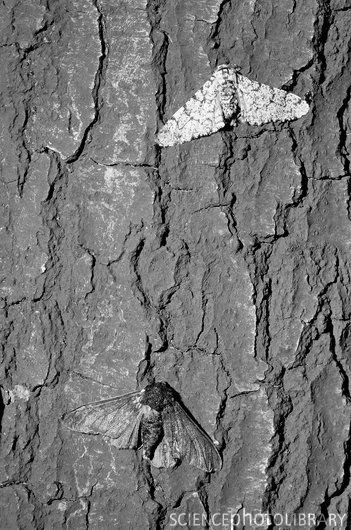
Naturalists, noticing this, wanted an adequate answer on why this was happening. In the 1950s Bernard Davis Kettlewell used various methods to test the hypothesis that it was natural selection. And indeed it was. Typica morphs were 2x more likely to be eaten in a polluted forest than carbonaria morphs, and vice versa.
This phenomenon was so common, and observed in many other moth species across industrialized areas, that it was even given a name: industrial melanism.
So there you go. The full story of the peppered moth :)
Oh and I should add that in areas where the effects of industrialization were reversed, the typica morph once again becomes more common.
Sources:
Peppered moths: moth life cycle
Peppered moths: natural selection
Peppered moths: dr ketllewell
#biology#charles darwin#moths are cute#pretty moth#moths#evolution#fun facts#peppered moth#interesting#lepidopterology#rant#special interest#now u know my silly little fun fact that I've been wanting to tell everyone#insects#insect#critters#entomology#bugblr#my post
7 notes
·
View notes
Text
The north american peppered moth (Biston betularia) feels like and inherently bisexual animal to me, much in the same way as opposums (Didelphis virginiana) does (image for reference)
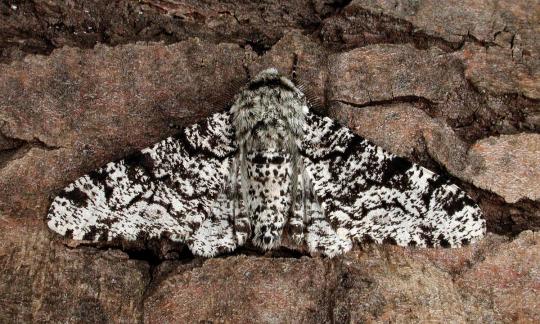
#cw insects#opposum#peppered moth#moth#bisexual#animals#I like to classify animals idk why it just feels right
2 notes
·
View notes
Text
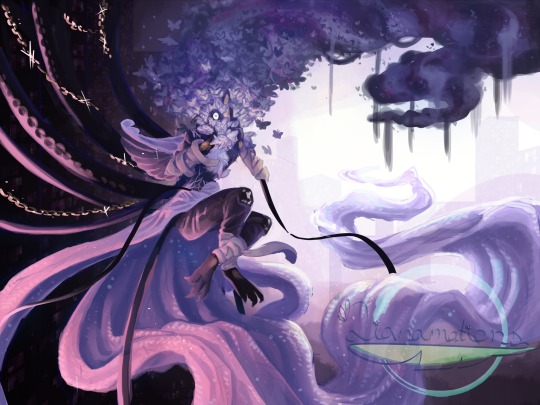



A symbolic depiction of one of my OC, Carbone descending into villainy, made for AP art. :,D along with a few details I felt particularly proud of.
Won’t go too in depth with the story and symbolism but I am curious to see people’s potential interpretation lol.
Ngl I feel kinda bad that I haven’t posted too much art here on Tumblr, but since summer break is coming soon I hope this will be my first step to being more active on here.
#my art#oc artwork#artists on tumblr#digital art#photoshop painting#anthro dinosaur#anthro oc#dinosaur oc#guanlong#symbolic art#symbolism#dinosaur art#biology#peppered moth
11 notes
·
View notes
Text

little peppered moth drawing so I could practice drawing moths
8 notes
·
View notes
Text
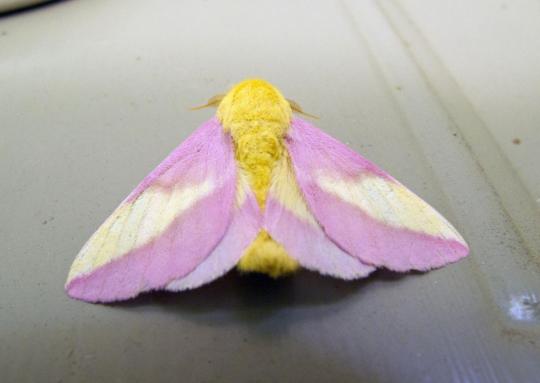



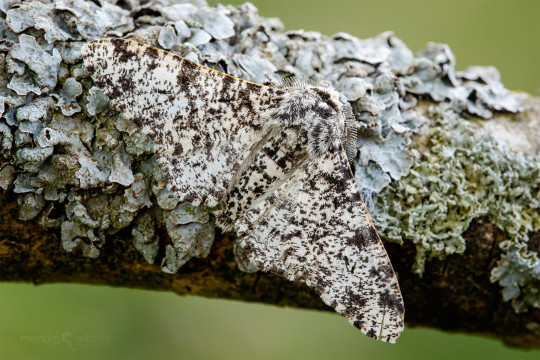
Happy National Moth Week!
38 notes
·
View notes
Photo
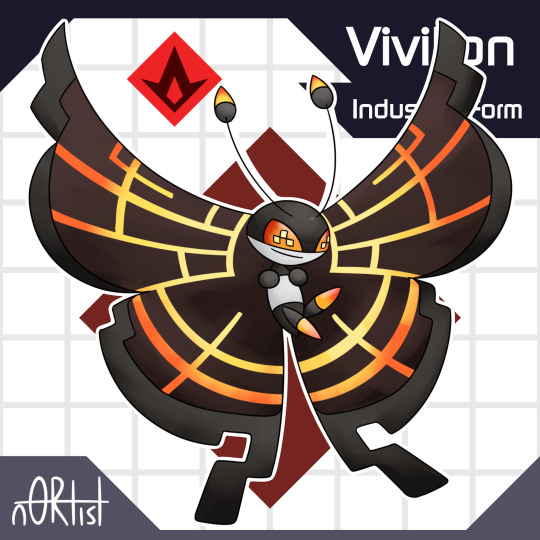

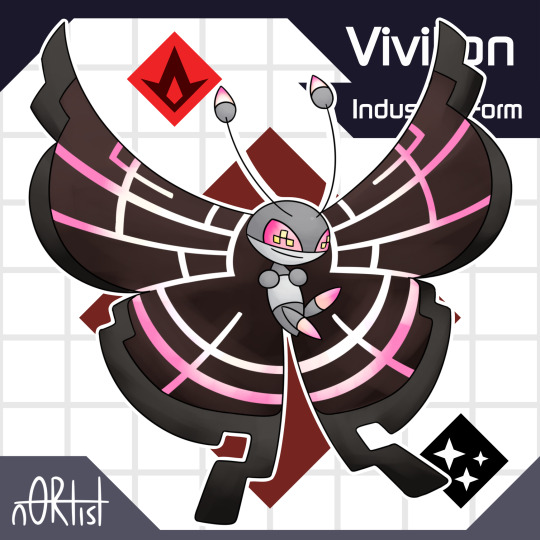
This was a #STEMARegional submission by @pugwafflez that I decided to include in my region.
As with any regional mons that deal with canon ones, these designs are separate from the region, and the Stema Region is not dependent on canon mons.
Here is a Vivillon form based off of the peppered moth, a popular example of natural selection. Natural selection is when one phenotype becomes more prevalent due to how well that phenotype does in the environment. The peppered moth generations became noticeably darker during the industrial age when the smog and pollution made the trees darker. The darker moths were able to camouflage better than the lighter colored moths. With the absence of that much pollution, lighter wings became more popular.
Vivillon [Industrial Form] (Bug/Fire): These darker winged Vivillons were more
prevalent during an older time when smog and pollution was rampant. The lights of these Vivillon only show up when they are in combat, allowing them to hide in the dark.
#pokemon#art#fakemon#science#fanart#education#biology#stem#natural selection#peppered moth#Logic & Passion#oc#steam#regional variant#vivillon
49 notes
·
View notes
Text
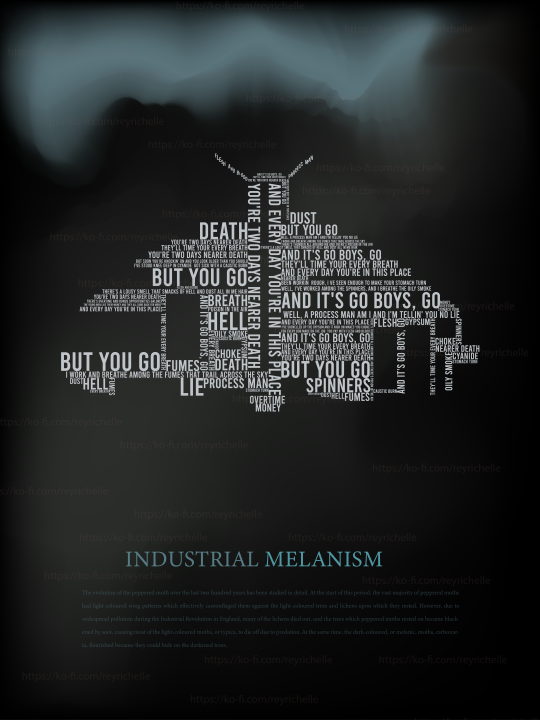
I wanted to share this poster that I made in April about the peppered moth!
The image description below has text if anyone is having a hard time reading it.
Image Description: A moth silhouette made of white text comprised of lyrics from the song The Chemical Worker's Song by Great Big Sea.
Behind the moth is a mostly grey and black smoggy background with hints of smoky blue near the top. Beneath the moth in blue title text it reads "INDUSTRIAL MELANISM".
Below the title in slightly lighter blue is the following paragraph from wikipidia
"The evolution of the peppered moth over the last two hundred years has been studied in detail. At the start of this period, the vast majority of peppered moths had light coloured wing patterns which effectively camouflaged them against the light-coloured trees and lichens upon which they rested. However, due to widespread pollution during the Industrial Revolution in England, many of the lichens died out, and the trees which peppered moths rested on became blackened by soot, causing most of the light-coloured moths, or typica, to die off due to predation. At the same time, the dark-coloured, or melanic, moths, carbonaria, flourished because they could hide on the darkened trees."
1 note
·
View note
Text
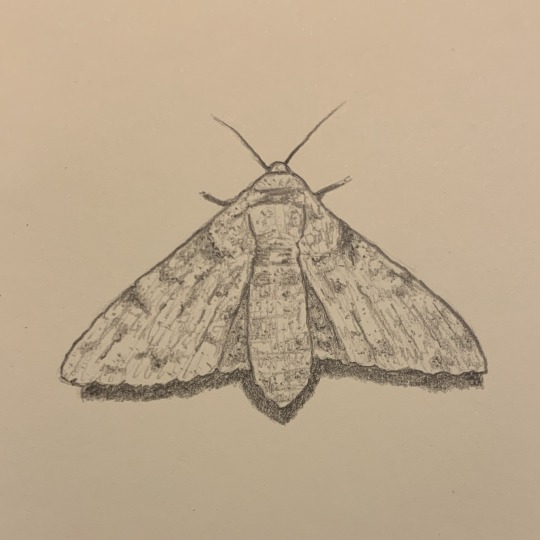
evolution - peppered moth
0 notes
Text
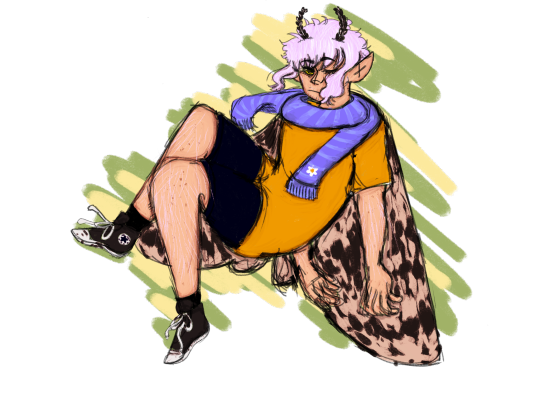
Probably post more info later
1 note
·
View note
Note
Hey, I was wondering if you had covered peppered moths yet ^^
Yes, you can find it here.
9 notes
·
View notes
Text

(oc) beltaine
1K notes
·
View notes
Text

Whole lot of bdubs 🪴
Honestly just wanted to practice drawing bdubs along with drawing some of the different designs I have for him + try drawing his new moss overalls mc skin >_<
#hermitblr#bdoubleo100#bdubs#bdouble0#bdoubleo100 fanart#bdoubleo fanart#bdubs fanart#hc bdubs#hermitcraft bdubs#moth bdubs#he is a peppered moth if you are curious :o3#also hes wearing Etho’s jacket in that drawing on the right if you even care or whatever or pshhh#had to get that dash of divorce duo in or id explode my bad </3#r3nrit art#ignore how I spelled thief wrong LMAOOO
746 notes
·
View notes